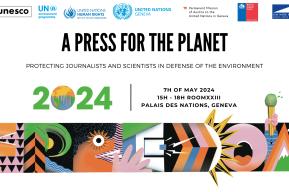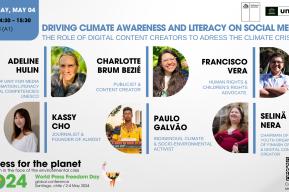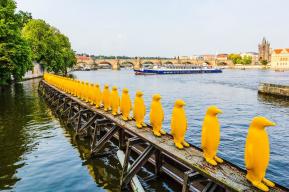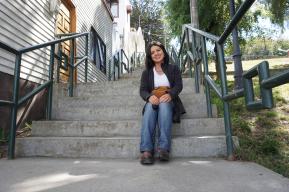On World Art Day 2024, the UNESCO Multisectoral Regional Office in Santiago interviewed Chilean muralist Alejandro “Mono” González about the significance of the date and the relationship between artistic expression and society.
Mono González took his first steps as an artist in school. In his hometown of Curicó, located in the Maule Region (200 km south of Santiago), he was selected for his artistic abilities to study at the Experimental Art School, the first primary and secondary art school in Chile and Latin America, located in Santiago.
As a child from a low-income family, with a father who was a laborer and a mother dedicated to homemaking, he found in art an opportunity to reach his full potential. At school, he was given tools to develop his talent and was taught by muralists Fernando Marcos and Osvaldo Reyes. Both had won a scholarship from the Chilean State agreement with Mexico to promote artistic education. Fernando Marcos was the school's director.
It was the influence of these teachers that led González to decide to become a muralist: "We students grew up surrounded by this; I was lucky in that regard. This is one reason why I dedicate myself to this, which has to do with academia. The other part has to do with the fact that I have always been linked to the social, to the political, to the events of my country."
González was a member of the student center at the Experimental Art School and part of the unions when he started his working life. "There was always a dialogue between culture, art, and political activity," he recalls from his school days.
The artist, with a degree in theatrical design from the University of Chile, is one of the founding members of the Brigada Ramona Parra, an organized group of muralists who use public spaces to convey their political message. The group had a significant influence in Chile in the years before and after the 1973 coup. Alongside painter Roberto Matta, González was responsible for the historic mural "The first goal of the Chilean people," created in 1971.
“I have always believed that art is part of the therapy of societies,” says González. “More than wanting to produce an impact, my proposition is to participate in society. I am a citizen, above all else. Sometimes I imagine a plumber or a bricklayer and think, ‘How do I contribute with what I am doing with my hands?’” he adds.
From a warehouse located in the Persa Biobío market in Santiago, where he has his works on display, González asserts: “The artist cannot be alone and enclosed. I can't imagine it. It has never happened to me, to stay locked in my intimacy. Here in the Persa, we are in a public place, where people look, are currently circulating, and observing what one shows them.”
What do you believe is the importance of celebrating World Art Day?
The importance lies in raising awareness within society. It's not necessarily that everyone should become artists, but rather that everyone should have access to art and culture. We're talking about visual arts, music. These days help to emphasize that attention must be paid to these cultural expressions.
Societies today are quite undermined. Among crime, drugs... there's a need to raise awareness, to fight against individualism, against selfishness and egocentrism, to fight for the values that have been lost. Art can help to sensitize, to foster solidarity, to build community, to construct a just society. In this sense, I believe that art must somehow be there, participating in these constructions. To me, art is closer to life than to death. When one talks about the importance of artistic expression or art, it relates to this, it's more about life than about death.
I can't imagine what the world would be like, for example, if Picasso's Guernica hadn't existed as a flag of protest, or Goya's Disasters of War. I can't imagine if there hadn't been that sensitivity of the artist to capture the surroundings. It's an art that ultimately becomes part of history, in the sense of the context in which it is born, develops, and represents. It's also testimonial, in that sense.
What are the challenges for young people who want to dedicate themselves to art, particularly those in poverty?
The first challenge for those who want to pursue art with limited resources has always been to break the barrier, to break it: to educate themselves and survive. The second challenge, which is more well-known today, is to open up space for the young, to be generous in giving opportunities to the youth. For example, we are now opening a workshop, and in this "Mono’s Printmaking Residences" workshop, we will have a space where we will have a press for the youth to come and print and exhibit their engravings.
We have to give young people opportunities, because there is a lot of talent that sometimes gets lost. Along my journey, I've met many young people, very talented, but who, due to their economic situation, political situations, etc., have not been able to emerge. They have been left behind. When young people say they are going to study art they feel they are going to starve to death. But by fighting, being stubborn, persevering, I have managed to survive. Coming from that same poverty.
Is there any message you would like to give for World Art Day?
To those who want to study art, be stubborn, do not give up along the way. It's difficult, sometimes I've had to alternate, to do my work, with other types of jobs, between carpentry and scenography, with which I've managed to feed my children or educate them, in part. We have survived and are still creating. I am 77 years old, we have managed to bear fruit. People recognize the value of things, or identify with what one represents.










